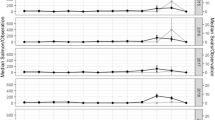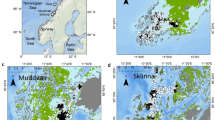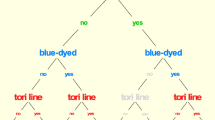Abstract
The rate of foraging attempts by black–browed albatross on baited hooks during Spanish-system (demersal) longline-setting operations, and a range of environmental and operational variables were used to investigate the relationship between their foraging behaviour and their mortality level. Logistic regression highlighted that a complex range of environmental and operational variables and black-browed albatross abundance combined to determine their mortality level. Our results suggest that, examined over a relatively short time period with minimal environmental variation, the rate of black-browed albatross foraging attempts during line-setting significantly affects their level of mortality. However, as a range of variables influence mortality, until targeted experimental studies are conducted, we suggest that caution should be exercised when using the rate of black-browed albatross foraging attempts as an index of their mortality.


Similar content being viewed by others
References
Agnew DJ, Black AD, Croxall JP, Parkes GB (2000) Experimental evaluation of the effectiveness of weighting regimes in reducing seabird by-catch in the longline toothfish fishery around South Georgia. CCAMLR Sci 7:119–131
Ashford JR, Croxall JP (1998) An assessment of CCAMLR measures employed to mitigate seabird mortality in longlining operations for Dissostichus eleginoides around South Georgia. CCAMLR Sci 5:217–230
Ashford JR, Croxall JP, Rubilar PS, Moreno CA (1995) Seabird interactions with longlining operations for Dissostichus eleginoides around South Georgia, April to May 1994. CCAMLR Sci 2:111–122
BirdLife International (2000) Threatened birds of the World. Lynx Edicions
Boggs CH (2001) Deterring albatrosses from contacting baits during swordfish longline sets. In: Melvin EF, Parrish JK (eds) Seabird bycatch: trends, roadblocks, and solutions. Alaska Sea Grant College Program, Fairbanks, pp 79–91
Brothers N (1991) Albatross mortality and associated bait loss in the Japanese longline fishery in the Southern Ocean. Biol Conserv 55:255–268
Brothers N (1995) An investigation into the causes of seabird mortality and solutions to this in the Spanish system of demersal longline fishing for Patagonian toothfish Dissostichus eleginoides in the South Atlantic Ocean. Parks and Wildlife Service, Tasmania
Brothers N, Gales R, Reid T (1999) The influence of environmental variables and mitigation measures on seabird catch rates in the Japanese tuna longline fishery within the Australian Fishing Zone 1991–1995. Biol Conserv 88:85–101
Cherel Y, Weimerskirch H, Duhamel G (1996) Interactions between longline vessels and seabirds in Kerguelen waters and a method to reduce seabird mortality. Biol Conserv 75:63–70
Croxall JP, Rothery P, Pickering SPC, Prince PA (1990) Reproductive performance and recruitment and survival of wandering albatrosses Diomedea exulans at Bird Island, South Georgia. J Anim Ecol 59:775–796
Duckworth K (1995) Analysis of factors which influence seabird bycatch in the Japanese southern bluefin tuna longline fishery in New Zealand waters; 1989 to 1993. NZ Fisheries Assessment Research Document 95/26
Food and Agriculture Organization (1999a) International plan of action for reducing incidental catch of seabirds in longline fisheries. FAO, Rome
Food and Agriculture Organization (1999b) The incidental catch of seabirds by longline fisheries: worldwide review and technical guidelines for mitigation. FAO Fisheries Circular no. 937. FAO, Rome
Gales R (1998) Albatross populations: status and threats. In Robertson G, Gales R (eds) Albatross biology and conservation. Surrey Beatty, Chipping Naton pp 20–45
Gales R, Brothers N, Reid T (1998) Seabird mortality in the Japanese tuna longline fishery around Australia 1988–1995. Biol Conserv 86:37–56
Gilman E, Boggs CH, Brothers N, Ray J, Woods B, Ching K, Cook J, Martin J, Chaffey D (2002) Performance assessment of an underwater setting chute to minimise seabird mortality in the Hawaii pelagic longline tuna fishery. Living Oceans Program, National Audubon Society, Honolulu
Hosmer DW, Lemeshow S (1989) Applied logistic regression. Wiley, New York
Huin N (2001) Census of the black-browed albatross population of the Falkland Islands. Falklands Conservation
Klaer N, Polacheck T (1998) The influence of environmental factors and mitigation measures on by-catch rates of seabirds by Japanese longline fishing vessels in the Australian region. Emu 98:305–316
Kock KH (2001) The direct influence of fishing and fishery related activities on non-target species in the Southern Ocean with particular emphasis on longline fishing and its impact on albatrosses and petrels—a review. Rev Fish Biol Fish 11:31–56
Løkkeborg S (1998) Seabird by-catch and bait loss in long-lining using different setting methods. ICES J Mar Sci 54:145–149
Løkkeborg S, Robertson G (2002) Seabird and longline interactions: effects of a bird-scaring streamer line and line shooter on the incidental capture of northern fulmars Fulmarus glacialis. Biol Conserv 106:359–364
Melvin EF (2000) Streamer lines to reduce seabird bycatch in longline fisheries.Washington Sea Grant Program, University of Washington, Seattle
Melvin EF, Parrish JK, Dietrich KS, Hamel OS (2001) Solutions to seabird bycatch in Alaska’s demersal longline fisheries. Washington Sea Grant Program, University of Washington, Seattle
Moreno CA, Rubilar PS, Marschoff E, Benzaquen L (1996) Factors affecting the incidental mortality of seabirds in the Dissostichus eleginoides fishery in the southwest Atlantic (subarea 48.3, 1995 season). CCAMLR Sci 3:79–91
Nel DC, Ryan P, Watkins BP (2002) Seabird mortality in the Patagonian toothfish longline fishery around the Prince Edward Islands, 1996–2000. Antarct Sci
Prince PA, Huin N, Weimerskirch H (1994) Diving depths of albatrosses. Antarct Sci 6:353–354
Robertson G, Gales R (eds) (1998) Albatross biology and conservation. Surrey Beatty, Chipping Norton
Ryan PG, Watkins BP (2002) Reducing incidental mortality of seabirds with an underwater longline setting funnel. Biol Conserv 104:127–131
Schiavini A, Frere E, Gandini P, Garcia N, Crespo E (1998) Albatross-fisheries interactions in Patagonian shelf waters. In: Robertson G, Gales R (eds) Albatross biology and conservation. Surrey Beatty, Chipping Norton, pp 208–213
Weimerskirch H, Brothers N, Jouventin P (1997) Population dynamics of wandering albatross Diomedea exulans and Amsterdam albatross D. amsterdamensis in the Indian Ocean and their relationships with long-line fisheries: conservation implications. Biol Conserv 79:257–270
Weimerskirch H, Catard A, Prince PA, Cherel Y, Croxall JP (1999) Foraging white-chinned petrels Procellaria aequinoctalis at risk: from the tropics to Antarctica. Biol Conserv 87:273–275
White RW, Reid JB, Black AD, Gillon K (2002) The distribution of seabirds and marine mammals in Falkland Island waters. Joint Nature Conservation Committee, Peterborough
Acknowledgements
Glen McPherson and Graham Robertson commented on an earlier version of this paper. SAST was funded by the Falkland Islands Government, and we appreciate their continued support. The support and assistance of Grant Munro, Consolidated Fisheries staff and crew of the CFL Valiant and CFL Pioneer were vital. Thanks are also due to the Falkland Islands Fisheries Department and Fishery Patrol Officers, the crews of the Dorada and Sigma, and Byron Marine for Fishery Patrol Vessel transfers. The Marine Resource Assessment Group (MRAG, UK) provided SAST with a blank copy of the longline database used in the Convention for the Conservation of Marine Living Resources (CCAMLR) waters.
Author information
Authors and Affiliations
Corresponding author
Rights and permissions
About this article
Cite this article
Reid, T.A., Sullivan, B.J. Longliners, black-browed albatross mortality and bait scavenging in Falkland Island waters: what is the relationship?. Polar Biol 27, 131–139 (2004). https://doi.org/10.1007/s00300-003-0547-3
Received:
Accepted:
Published:
Issue Date:
DOI: https://doi.org/10.1007/s00300-003-0547-3




